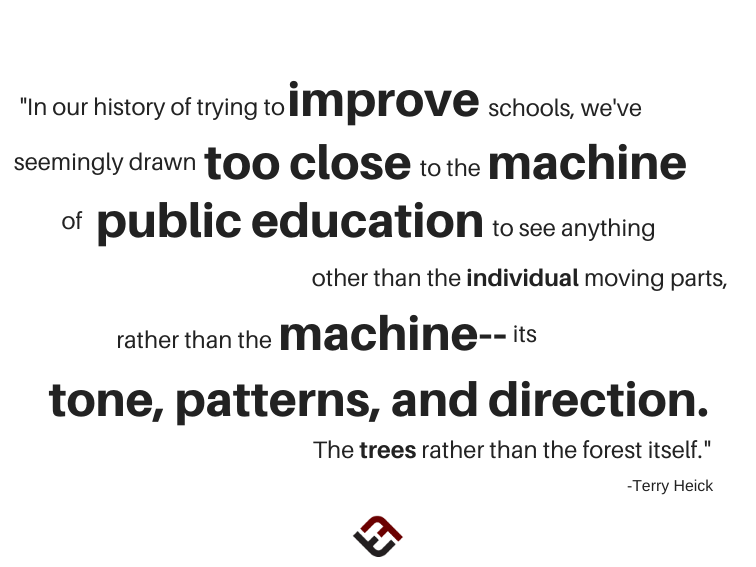What Are The Best Ways To Future-Proof Your Teaching?
by Terry Heick
It’s pretty clear–and frustrating–that in lieu of the incredible effort and expertise of teachers, and billions of dollars spent by departments of education globally, that our collective education landscape is decidedly mediocre. And everyone has an opinion on how to fix it–opinions that swing swiftly from one extreme to another.
See also The Role Of The Teacher In The Near-Future Classroom
The kids can’t read!
Schools focus too much on reading.
#edtech is the way forward.
#edtech is evil.
We need innovation!
Get off my lawn. I wrote essays and book reports all through school and I turned out okay. (Similarly, my doctor smoked, my house was covered in lead paint, and my grandmother never used a car seat for any of her children and none of them died.)
We give them too much homework.
Or not enough.
Poverty is a killer.
80/80/80 schools prove otherwise, yes?
School is boring.
School might be boring, but so is ‘the real world’ so they’d better get used to it.
We spoon-feed them too much.
If we don’t personalize instruction with constant learning feedback and support, how will they ever learn?
In many ways, this binary this or that condition reflects an authentically human spirit to dig in and fight, a dichotomy paralleled in our which is it, liberal or conservative? political system. We like simple choices and easy packaging, and that love of accessibility and convenience can extend to our collective thinking about complex issues.
How many new programs and books and initiatives do we have to ‘buy-in’ to see that something’s missing?
Learning Trend Fatigue: The Missing Discussion About Learning
Education, school improvement, the role of technology in learning, and other issues are really less about reform, and more about what’s missing in these discussions–the big picture. And this big picture starts with a basic question that precedes even discussions about standards and curriculum:
Why should children learn? Why do we educate? (And if you answer ‘college-readiness,’ go back and think some more.)
Any thinking about this crucial question immediately begins to inform other similar macro-questions:
- What is the best way for students to learn?
- Who should lead that kind of learning, and how exactly?
- What should we accept as evidence of learning?
- What should we do when they fail to demonstrate that evidence?
- More broadly, who is we? Teachers? Schools? Districts? Communities? Who else should be helping here, and how exactly?
What’s missing in discussions about learning is a sequence that moves from big picture–Why learn?–to the little picture–How then should schools–and the curriculum and assessments and grading system–be designed?
Oddly, this kind of conversation is not only uncommon, but sounds esoteric, clumsy, and nebulous, and decades spent reforming and billions spent updating education haven’t led us anywhere but a position where we increasingly recognize our own nakedness.
And this would be good, but in true human nature, we’re developing self-defense mechanisms that only make things worse in the long run, including thicker skin, the idolizing of learning technology, a mechanized dependence of ‘data-driven’ and technology-led teaching, and, more recently, learning trend fatigue.
We’re simultaneously tired of change, and evaporating as an industry without it. But that fatigue is important to honor. That so many teachers are tired of hearing it all isn’t simply proof they need to find new jobs. If a teacher doesn’t ‘buy-in,’ automatically labeling them a non-team player is a problem. After all, the best teachers often don’t do what they’re told anyway.
There’s more to the story–and ways we can begin addressing it all, with the following ways to future-proof your teaching.
8 Ways To Future-Proof Your Teaching
1. Be honest and be credible
Don’t just ask “Is this what’s best for the students?”–make sure you can offer a somewhat credible vision yourself of what might be. Imagine explaining the same thing to your own child or a future version of that student.
2. Think function over apps and brands
Don’t start with technology, start with function within the learning process. Consider which important problems technology can solve.
3. Think outcome over trend
Same with learning trends. Don’t simply think in labels and forms–‘challenge-based learning’ or ‘place-based education’ for example–but rather how to promote it-takes-a-village buy-in from the local community. Consider what you’re trying to accomplish by choosing this model or that strategy or this framework.
4. Always consider the ‘macro’
As a teacher, spend at least as much time learning about learning models and curriculum and human communities as you do on data and ‘research-based instructional strategies.’ This will help you identify new/better/more engaging ways to learn.
5. Listen to students
Spend as much time listening to students as talking to them. And when you can, let them lead.
6. Emphasize people, thinking, and literacy.
Design lessons and units that focus on human interaction, critical thinking, and self-directed learning. Decenter yourself at all costs.
7. See all the ‘sides’ of teaching and learning
Teaching isn’t simply pedagogy. Rather, it’s an often-tangled tapestry of social, cultural, knowledge-based, and technological practices. In response, develop patterns, workflows, frameworks, and learning models that value both the art and science of learning.
Continue to build social capacity when, where, and how children learn through increased transparency, programs, and substantive dialogue and ongoing conversations between students, educators, community members, content experts, and anyone else that can help that child’s life improve–today and in the future.
8. Focus on how students live–today
8. In every single issue of curriculum, assessment, instruction, school design, or related conversation, trace back to purpose: How will this–directly or indirectly–make the lives of my students better? And the more it’s ‘direct’ than ‘indirect,’ often the better.
If you’re discussing how frequently you should administer a district common assessment, think about what can (reasonably) be done with that kind of data, what has happened in the past in similar situations, and what the immediate impact on learning experiences for students might be.
The Big Idea
In general, the idea is to use macro thinking to at least inform decisions. Trying to decide whether to drop art and music? Buy iPads or Chromebooks for Google Classroom? Adopt project-based learning? Think first on as wide a scale possible, and work backward from there.
What are the goals here? Where have we been, and where are we going? What patterns reveal themselves if we stop for a second and look? What have we missed in the past when making these kinds of decisions?
Why do children come to school, how do they like to learn, what are their thinking habits, and how can all of this inform our decision to, for example, adopt a BYOD program or hire a new teacher? There is a relationship between all of this, and not seeing it has cost us too much.
In our history of trying to improve schools, we’ve seemingly drawn too close to the machine of public education to see anything other than the individual moving parts, rather than the machine, its tone, patterns, and direction. The trees rather than the forest itself.
This has unsurprisingly left us a bit tired of staring at these parts, no matter their shiny new coat of paint or clever, eye-catching design. Learning trend fatigue is just one example. So let’s balance the tempting focus on trends, tools, and gadgets with the kind of big-picture vision that can inform our use of it all. We hope these ways to future-proof your teaching can help you ‘evolve smarter’ versus ‘harder.’
The Big Picture: 8 Ways To Future-Proof Your Teaching

